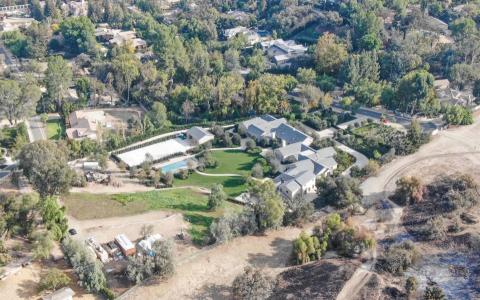
When one $60 million mansion burns and another is saved, it used to come down to luck. Now the insurance companies decide who’s too big to fail.
After your clients reach a certain level of wealth, disaster and picking the wrong advisors are the only things they need to worry about.
And today’s fortunes scale to levels where the disasters need to be truly massive to even trigger the inconvenience of an insurance claim.
Take a look at Kim Kardashian and Kanye West. Their $60 million house is right on the edge of wildfire country and was extremely vulnerable to the worst outbreak in California history.
Their money ensured that private crews worked around the clock to keep the fire away. How did they do it and what do they have to be afraid of now?
Luxury policies don’t want to pay
Kardashian and West didn’t hire the firefighters themselves. The crews came to their house on behalf of the high-end insurance carriers that cover the property.
The effort makes perfect financial sense. While it’s hard to evaluate ultra-high-net-worth property values, this particular house was worth at least $20 million new and has another $20 million in improvements on the grounds.
Some people report that it’s worth $60 million now. That’s probably what it’s insured for. The owners pay a little more from year to year for the inflated policy but receive an elevated payout if it’s destroyed.
Either way, the carrier wants to do whatever it can to keep from paying out. If that means taking heroic measures to save the property from disaster, then $60 million can buy a lot of heroism.
Private crews are working right now to guard 1,000 homes in California alone. It might cost $10,000 a day to call them in.
It’s a big bill for the typical suburb, but with $60 million on the line the carrier can keep the crews in the field for 16 years and still save money even if the house burns down in the end.
Of course that’s a literal worst case scenario. At most digging the fire breaks for a single season might cost the carrier $100,000, which is probably at the far low end of the premiums Kardashian and West are paying.
Sending the crew cuts into profit and keeps the policy intact. Not sending the crew triggers a catastrophic claim. When you’re the underwriter, the decision is obvious.
And when you’re the person who owns the property, the choice of carriers is equally obvious. If you’re living in the Hidden Hills surrounded by brush and far from urban services, you buy the policy that works harder to keep the fire away.
We’re hearing about a lot of star houses “miraculously” saved from total destruction. Anthony Hopkins, Pierce Brosnan, all the Kardashians. Maybe it’s good luck but realistically it’s probably just better insurance.
That’s a game changer for wealthy households who’ve historically shielded themselves from the financial drag of disaster but not the heartache, personal danger and inconvenience.
What do you have to be afraid of?
Acts of God are the last worry multi-billionaires face.
Put $1 billion in Treasury bonds and index funds and the interest will cover upkeep and security on any reasonable collection of mansions and hobby charities, leaving the principal to build up for the next generation.
That portfolio is built to withstand any economic shock short of total disaster.
From there, it’s all about managing risk to get the smoothest, longest ride possible. It’s about investing in the best personal healthcare available and pushing the scientific envelope when needed.
It’s about preventing everyday threats. A smart billionaire won’t get mugged on the street. A simple security protocol ensures that if he or she wants to wander, there are people watching.
Then it becomes a matter of guarding your stuff. Gated communities and gated nations like Singapore or increasingly New Zealand put some distance between you and social threats.
A lot of big political donations also revolve around this simple objective.
And you insure your property to get the carriers involved. A big enough homeowners policy is literally too big for the insurance industry to let it fail.
Pool enough policies in a street or neighborhood and you can get all the carriers working on your behalf. With the Kardashians, saving their house apparently meant saving everyone else on their street as a bonus.
It doesn’t matter whether those houses were insured with the same company that hired the crew. What matters is that the company does the calculations for the entire neighborhood and decides where to send the crews.
Is this the future? That really depends on where society goes, which is itself a question billionaire money is fighting to resolve right now.
If the Kardashians were living in a Manhattan condo on fire, it would be much harder for anyone to save the building, much less pinpoint which penthouse to protect while leaving the rest to burn.
Rural property is both more open to nature and more isolated from other interests. It’s yours. If you pay to defend it, odds are good the resources won’t be “wasted” on your neighbors — unless, of course, that’s what you want.
The Kardashians look like heroes in their neighborhood because their private crew showed up. Maybe that turns into a community fund and a well funded private disaster force, something like a homeowners association with its own army.
It makes financial sense. But you have to actually like your neighbors and feel a vested interest in staying friendly. You have to be happy when their house survives.
But every billionaire needs to do what it takes to protect their house first. From there, the sky’s the limit — fight the climate, fight disease, fight the public mood.
It’s what big money is for.



